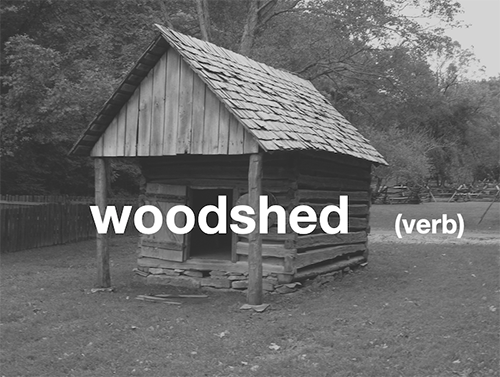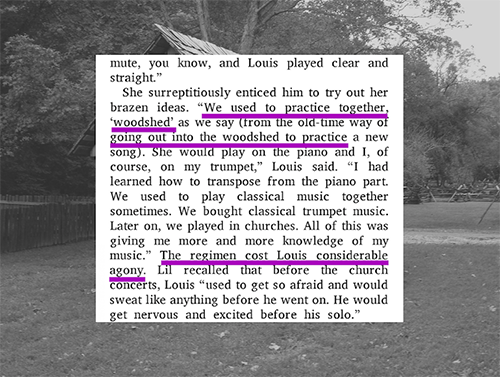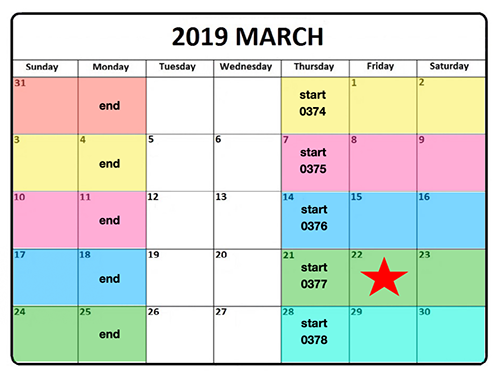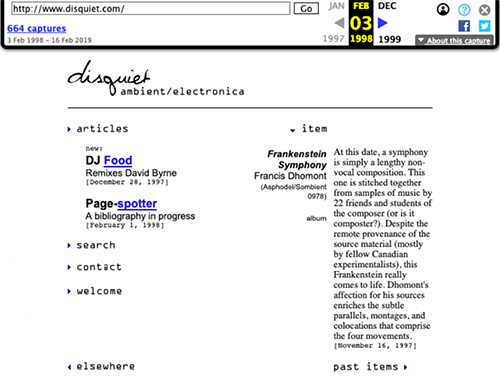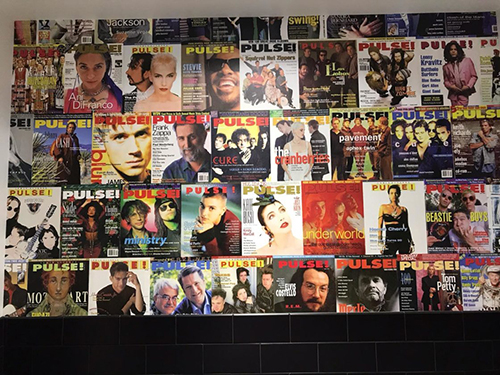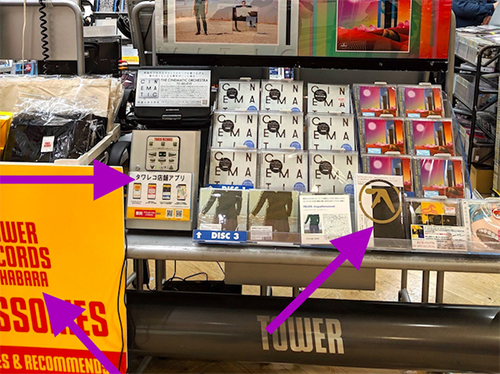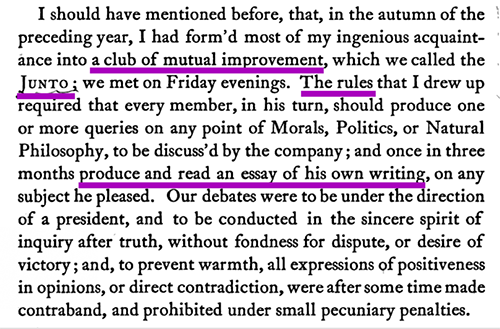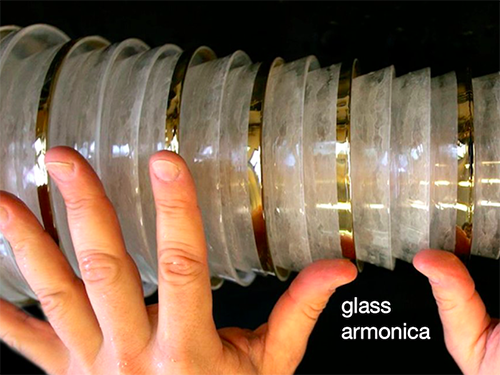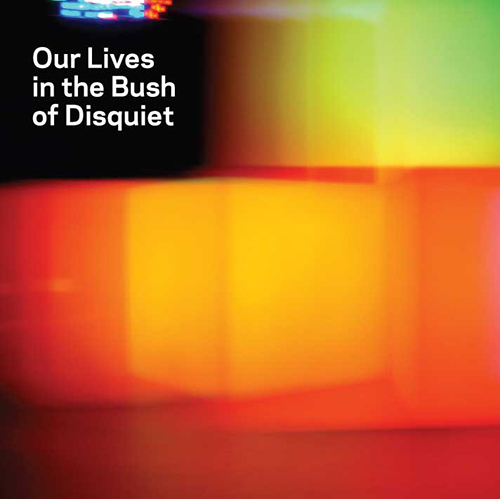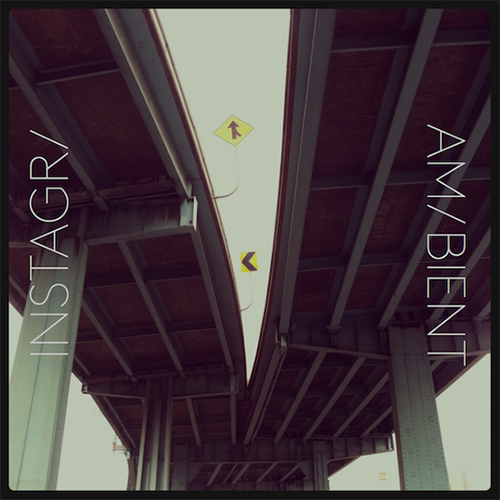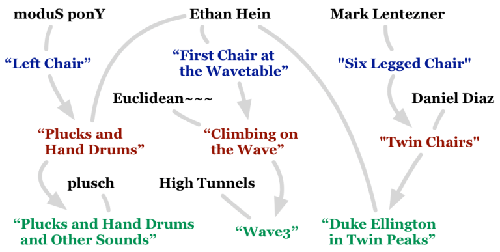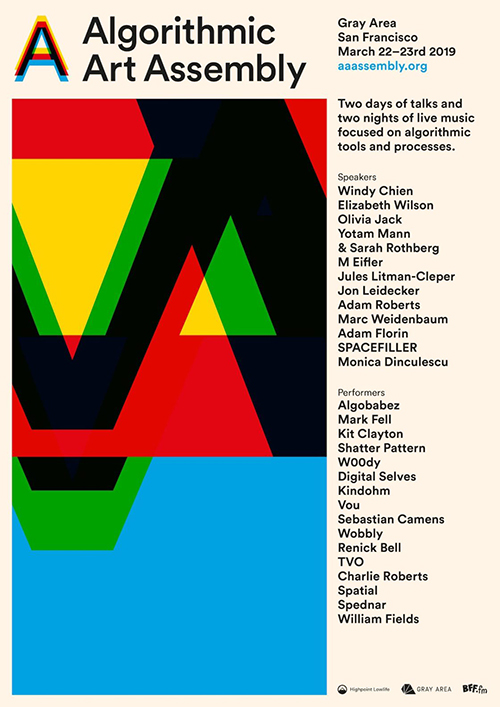Cross-post (7)
By:
January 23, 2020
The woodshed is a black box.
Marc presenting at Algorithmic Art Assembly, March 2019
I want to talk about the algorithms we call music communities.
The petri dish in which this activity takes place is often called, in musician vernacular, the “woodshed.”
The “woodshed” is the classic place to which a musician retreats in order to practice, to work things through, to self-improve. This venture is often thought of as a solitary one — a self-funded, low-budget “artist’s retreat of one.” I will also show that the solitary aspect of it actually isn’t necessarily the case, or the optimal case.
Now, “woodshed” is the sort of word that doesn’t really require detailed etymological dissection when being introduced as a topic. You put “wood” and “shed” together, and you kind of get the picture. One thing that should be noted, though, is that “woodshed” is more often, in this context, not a noun but a verb. One may “go to a woodshed” as a musician, certainly — but more likely, one will “woodshed.”
The word “woodshed” has particular presence in jazz, and it appears frequently in the biographies and autobiographies of jazz musicians. This bit is from Louis Armstrong: An Extravagant Life, Laurence Bergreen’s 1997 book on the early jazz trumpeter.
The “Lil,” named here, providing this anecdote is Lil Hardin Armstrong, Satchmo’s second wife (second of four, if you’re keeping track). I like that even from the vantage of the 1920s, the word “woodshed” was already a throwback to a still-earlier time.
This probably goes without saying, but one other thing to note about woodshedding is that it’s only really woodshedding if it takes a toll, hence the comment about Armstrong’s nerves.
The woodshed I’d like to invite you into is one called the “Disquiet Junto.” It’s a music community that’s been running for — well, it’s into its eighth year now. Specifically, it’s now in its 377th consecutive week, as of yesterday, March 21st, 2019.
I know the weekly count is up to 377, because weekly projects are the organizing principle of the Disquiet Junto community.
The way the Junto works is as follows. Each Thursday a compositional prompt is sent out to the music community — currently 1,300+ people on the email announcement list — and they have until the following Monday to respond with a piece of music.
I’ll talk more about the Junto shortly, but since we’re gathered in San Francisco to engage with algorithms and culture, how about we start things off by making some culture?
What follows is the current Disquiet Junto project, done in coordination with the Algorithmic Art Assembly. This will be a sequence of instructions, an algorithm as it were, in six steps, with some extra credit. Every Junto project comes as a series of steps, sometimes as few as one, sometimes upward of 10 steps or so.
This week’s project was proposed to the Junto community by Charlie Kramer, a Junto participant who records as NorthWoods and mostly works in ChucK, the audio programming language. Not every Junto musician works directly in programming language to accomplish their weekly projects, but many do. Kramer is one. Another is Erika Nesse, a Boston-based coder and composer. Her work involves fractal investigations of sound. I have too many to share, so I may post examples to Disquiet.com after the conference for those who are interested.
So, let’s get going with Charlie Kramer’s prompt.
These following instructions comprise this week’s Disquiet Junto project, and it’d be super if you take a little time — if you have some time — over the course of the weekend to participate. I’ll read the instructions through here quickly, but it’s online for reference later, at the fairly human-readable URL disquiet.com/0377.
Step 1: Define a scale of 8 notes (or sounds).
Step 2: Create a melody with 4 notes from the scale resulting from Step 1.
Step 3: Replace note 2 in the melodic sequence from Step 2 with an unused note (selected deterministically or randomly). Then do this for note 4, then for note 3, and then for note 1.
Step 4: Reintroduce the first melody as counterpoint to the result of Step 3. This establishes a pair of notes at each point in time.
Step 5: Repeat the algorithm on these pairs. Repeat to create triplets.
Step 6: Sequence variations to create a piece of music.
Extra credit: Do the same with note durations and velocities (e.g., 8 possibilities, 4 choices).
I want to talk today about the way this music community, the Disquiet Junto, functions algorithmically — how the Junto was created as a result of rules, how the Junto employs rules, and how the Junto engenders rules.
Which is to say, I want to talk how rules formed, shape, and fuel the Disquiet Junto.
Since rules are expressed in language, let’s start with language. I think it would help to explain where the name “Disquiet Junto” comes from in the first place, since we’re talking about how language leads to things. Language, like, rules, has consequences — sometimes, as we known, unforeseen ones.
The “Disquiet” is from the name of a website I founded in 1996. It’s called Disquiet.com, and it continues to run to this day.
This image of the early home page is from the Wayback Machine at the Internet Archive. (One odd thing about living in San Francisco is how local the internet is. The apartment I lived in in the city’s Richmond District from 1996 to 1999 was a block and a half from the gorgeous building the Internet Archive calls home. I don’t live much further from it today.)
For all intents and purposes, Disquiet.com is a blog, though since I started writing regularly on the website before the word “blog” surfaced, I feel like it can claim some allegiance to a more nebulous territory — perhaps the existence of the Disquiet Junto is one thing that reinforces that potential variety.
When I purchased the URL Disquiet.com in 1996 — an action, I will add for the younger people in the crowd, that required a fax machine and a phone call, and quite a bit of time sitting around waiting — I had just left Tower Records after seven years there as a full-time editor on the company’s print music magazines.
These included Pulse!, which existed before I got there. Those covers there are now wallpaper at Solomon’s Delicatessen in Davis, California, named in honor of Russ Solomon, who founded Tower Records in 1960. There were also two magazine that I helped found: Classical Pulse!, which as the name suggests was about classical music, and epulse, which as the “e-” suggests, de rigueur at the time, was an online publication, Tower’s first online publication — an email magazine that went out weekly more or less from 1994 to 2004, which is when bankruptcy began to shut Tower’s doors — except for peculiar vestiges, like the thriving stores that exists to this day in Tokyo, Japan, in neighborhoods like Shibuya and, pictured here, Akihabara.
Here’s a picture shot by Donald Bell just this month in the Tower in Akihabara. If there are any Tower Truthers out there, this does exist — note the cover of the Japanese edition of my book on Aphex Twin’s album Selected Ambient Works Volume II. It was published this month.
Anyhow, I founded the website Disquiet.com because shortly after leaving Tower to take a new job — at what was then called a “dotcom,” an entity later rebranded a “startup” after the crash soiled the halo of the earlier word — I realized how much of my own identity was tied up with the being a full-time music editor — something I no longer was. I realized that having a place where I published regularly would provide me the identity I felt lacking. I cast about for names for this identity, and settled on a shortlist, and eventually went with Disquiet.com. I focus on ambient music and sound in my writing, and more broadly on what I’ve described as the intersection of sound, art, and technology, or sound, culture and technology. (I keep going back and forth between those.)
The tagline for the site is “Listening to art. Playing with audio. Sounding out technology. Composing in code.” The prominence of code as a form of composition has increased significantly over the course of the website’s 20-plus years of operation. There are few benefits to aging — just ask my knees — but hindsight and perspective have some value.
The word “Disquiet” I’d borrowed from a beloved book by Fernando Pessoa, the late Portuguese poet. It’s titled The Book of Disquiet. Pessoa died in 1935, and the book came out posthumously.
Technically, Pessoa isn’t the attributed author of The Book of Disquiet.
The Book of Disquiet is credited to Bernardo Soares. Soares is Pessoa, in that it’s a name Pessoa used sometimes when writing.
Bernardo Soares is one of dozens of names — dozens of identities — that Pessoa created and used. Let’s not say “that.” Let’s say “whom” — dozens of identities whom Pessoa created and used. Other such identities included Alberto Caeiro, Álvaro de Campos, and Ricardo Reis.
Pessoa came up with so many names that he became synonymous not just with all those invented people, but with the whole concept of having multiple presences. So, the word he’s most synonymous with is the word for that concept, which is the word “heteronym.”
I didn’t actually think much at the time, in 1996, that while casting about for an identity for myself, I had instinctively grabbed as a lifeline a word employed by someone famously conflicted about having a specific identity — or that I hadn’t even grasped the word that firmly, since I was using a translation of the word that Pessoa had himself used. The actual title of the book is in Portuguese, of course, the language in which Pessoa wrote. That book’s title is not The Book of Disquiet. It is Livro do Desassossego.
That word there, a dozen letters long, didn’t seem it would work well as a URL. So, I’d gone with Disquiet.
Someone did buy it at some point, apparently. It is apparently available now, if you have two grand.
To sum up Pessoa’s Disquiet, engaging with his work instilled the word “Disquiet” for me with several key concepts for me and my work, what I’d call creative restraints — the source of what later became the rules of the Disquiet Junto — that are core to whatever comes out of the website. These can be summed up as matters of (1) identity, (2) publishing, and (3) writing (in my case music criticism).
Anyhow, that’s Disquiet. The other half of the “Disquiet Junto” is the word “Junto.” This word’s source is older still, by about two centuries.
I borrowed the word “Junto” from one of the founding parental units of the United States, Benjamin Franklin. It was in 2012 that I did this. That’s when the Junto launched, the first week of January 2012. I had just finished reading Walter Isaacson’s biography of Franklin, which was published about a decade earlier, and I was struck by the name and concept of this Junto club that Franklin had formed in 1727. I’d read Franklin’s autobiography in college, but I’d forgotten a lot of this until I read Isaacson’s book.
As I understand it, Franklin, who while being brilliant had a bit of a self- consciously macho thing going on, took the word “junta” and chose to make up a masculine version of it. In any case, what appealed to me wasn’t the hegemonic sexism the colonial America, but the purpose of the Franklin’s Junto, which he described in his autobiography as “a club of mutual improvement.”
I was fascinated by this idea of “mutual improvement,” which I read to mean mutual self-improvement. There’s a tension between “mutual” and “self” that I lingered on.
I also considered the “rules” — his key word there — that played a role in all this, and the idea that all the Junto participants created original work (“his own writing”) and then shared it with their fellow members, presumably for discussion.
Benjamin Franklin was something of a serial creator of clubs — he helped form an early fire department a decade after the Junto, and years later what became the University of Pennsylvania. In many ways, the Junto was a trial run for the biggest club that Franklin helped form, the United States of America, the founding “rules” for which appear in the Declaration of Independence and the Bill of Rights. From little things, big things grow.
To sum up, if Pessoa’s “Disquiet” provided an impetus toward (1) identity, (2) publishing, and (3) writing, then Franklin’s “Junto” contributed to an understanding of and appreciation for (1) mutual (self) improvement, (2) communal rules, and (3) creation (in this case music).
Now, if there are any admirers or scholars of Benjamin Franklin out there, you may be thinking, “Yes, yes — the Constitution is a nifty document and all, but what about the ‘glass armonica’?” It is true that Benjamin Franklin, among his many inventions and improvements to existing technology (and what are most inventions but improvements upon something already in existence?), developed his own glass armonica, a version of which is depicted here.
Early on in the Disquiet Junto, we did a project based on the glass armonica. It was one among many as the structure of the community slowly came into form. We also did one drawn from Franklin’s autobiography.
All Junto projects come in the form of steps — a sequence of instructions. The very first project was just a one-line instruction: “Record the sound of ice in a glass and make something of it.” When I started the Junto with that prompt, I didn’t know if there would be a week two. About 60 or so musicians joined in, and it’s rolled weekly ever since.
There were proto-Junto projects. I’d been doing my own compilation albums over the years. After interviewing musicians for nearly 20 years professionally, in 2007 I reached out to several for what became Our Lives in the Bush of Disquiet. My interviews with musicians had often been conversations, which is to say pursuits of ideas. The first of these was an opportunity to pursue those ideas more directly. At the time, Brian Eno and David Byrne had created a website where they posted stems, which is to say: layers and elements of the original recording. They invited people to rework the source material and upload it to the site. I loved the idea, but couldn’t stand most of what I heard. So, I contacted several musicians whose work I admired and asked if they would participate in the Eno-Byrne remix effort. They agreed to, but many said they also didn’t like the music on the website, and wondered if I’d collect the material. From that, the first proto-Junto album arose, Our Lives in the Bush of Disquiet. This was a major moment for me: Rather than conversing with someone about a musical hypothesis, we put the hypothesis to work.
Several of these compilation albums followed. In the years that passed, I’d come to realize that at many of the concerts I attended, most of the audience were themselves musicians. This was sort of a joke, a negative one, but I wondered what if it were a positive thing — musicians making music for each other. I decided that having previously hand-picked the participants in these pre-Junto projects, I would open it up more. I floated an idea — which is to say, I posted on Twitter — an invitation. People who made ambient music would email me one of their Instagram photos, and I would re-distribute the photos. Everyone who participated would receive someone else’s image. They would be told, “This is the cover of your next single. Now go record it.” That project was titled Insta/gr/ambient, with 25 musicians involved. Both those covers are by Brian Scott of Boon Design. He did a tremendous job. [Ed. note: we covered Marc’s Insta/gr/ambient project on HiLobrow in 2011.]
After Insta/gr/ambient, I wanted to push further this idea of musicians making music for and with each other, which led to the idea of doing away with the commission model entirely: just open it up to whoever wants to participate, when they’re available. The Junto was originally formed to take advantage of the SoundCloud Groups functionality. The groups functionality eventually went away, leading to something of a Junto diaspora. We still function mostly on SoundCloud, but the Junto has survived the very code that had engendered it, and is now pursuing a post-platform reality. These days it takes place on Lines (aka llllllll.co), Disquiet.com, via an email announcement list (currently TinyLetter), most music on SoundCloud, but also to YouTube, Clyp, Vimeo, and Bandcamp, among other places.
There are many communities like the Junto. Some came before, some came after. Iron Chef is all shared samples. Stones Throw Beat Battles, which like Iron Chef predates the Disquiet Junto, has the most systematic approach: whoever wins the weeks battle (they vote) chooses the same and rules for the next week. Stones Throw has a great model, in that it is self-propelling. It’s a hip-hop community. Each week, a different sample is proposed to the community, and whoever makes the best beat from it — everyone can vote — proposes the next sample.
Two key communities that came after the Junto are Naviar Haiku and Weekly Beats. Every Naviar project responds to a haiku of the week. Weekly Beats, which alternates years, is wide open: you post what you like once a week, though there are sometimes proposed approaches for participants to consider engaging with. There are also several key artistic movements that engaged deeply with rules-based art making, and among the ones on my mind have been Oulipo, Fluxus, and Deep Listening.
Now, for all the rules-based nature of these Junto projects over the years, I actually had very few conscious rules as I started out. Over time, however, four rules became clear in retrospect:
Projects are doable without prior (or intended subsequent) involvement in the Disquiet Junto.
Projects are doable in one session, even if it might be a long session.
Projects are doable offline — once you’ve gotten started, you don’t need a wired connection.
There are no “winners.”
Those are the rules of the Junto, the bylaws of the network of woodsheds into which Junto musicians enter. The woodshed is a black box, a friendly crucible in which we are transformed — not just individually, but collectively. I’d been pondering the network of woodsheds that is the Junto before I read that Louis Armstrong biography — even though I was fully comfortable with the concept of non-isolated self-improvement as a musician, I was very happy to learn that the concept of the woodshed as a solitary pursuit was overstated. Not overstated is how true woodshedding means getting out of what some will call their comfort zone. This is from an article by the music journalist Lottie Brazier from the British magazine The Wire, quoting a Junto participant, Richard Fair: “…out of my comfort zone and forced into using different techniques or alternative approaches.”
One benefit of the networked creative space is when musicians want to collaborate they can. Some Junto projects build on previous ones. You can still join in at any time, but if you join early, you can experience your own music in new ways. This is another aspect of the Junto being a black box: there are opportunities to put your own music in, and then see what others make of it. Ethan Hein drew up this excellent flowchart of one such project.
This following comment — also from Hein, and also from that same Brazier article — is my favorite thing anyone has said about what the Junto is. It gets to the heart of how the projects are reverse-engineered from ideas. A concept is investigated, then broken down into steps, and then shared with the community to see what they make of it: “He writes reviews of music that doesn’t exist yet and then gets internet strangers to make it.”
And that is the Disquiet Junto. This talk has been an attempt to probe the algorithmic — in the broad adjectival sense — aspects of music communities, and its also been an invitation to participate. Many Junto projects, such as the one we’re doing this week, are initiated by members of the community. Sometimes, as well, they come from people outside the community. We’ve had writers, and artists, and other musicians propose ideas to the Junto in the form of multi-step projects.
I wanted to just share a thanks to folks who have, both recently and pertinent to this talk in the past, coaxed these ideas. I spend a lot of time writing about other people’s art. In many ways, the Junto has gone un-self-observed by me. I appreciate Thorsten Sideb0ard’s invitation as an opportunity to look inward:
Aroon Karuna
Brian Scott
C. Reider
Chris McAvoy
Lottie Brazier
Molly Sheridan
Niki Korth
Ted Laderas
Paolo Salvagione
Peggy Nelson
And I also want to share the photo credits (only listed here are the ones depicted on this page — more were in the presentation):
Donald Bell’s Tower Records Japan
Ethan Hein’s flowchart
Glass armonica (Wikipedia)
Jason Bergenfeld’s Solomon’s Deli
Land Between KY/TN’s woodshed (flic.kr/p/dV2bhD)
And that covers it. Thanks very much, and if you do have the interest in joining in, whether to make music or to propose a step-based project or both, please do.
On Friday, March 22, 2019, I had the great pleasure of speaking as part of the first Algorithmic Art Assembly, a two-day combination of daytime talks and evening performances. The video and transcript above are from that talk, entitled “The Woodshed is a Black Box.”
Marc’s original post on Disquiet: The Woodshed is a Black Box
The Disquiet blog: https://disquiet.com/
Subscribe to This Week in Sound
Marc on Twitter: @disquiet

